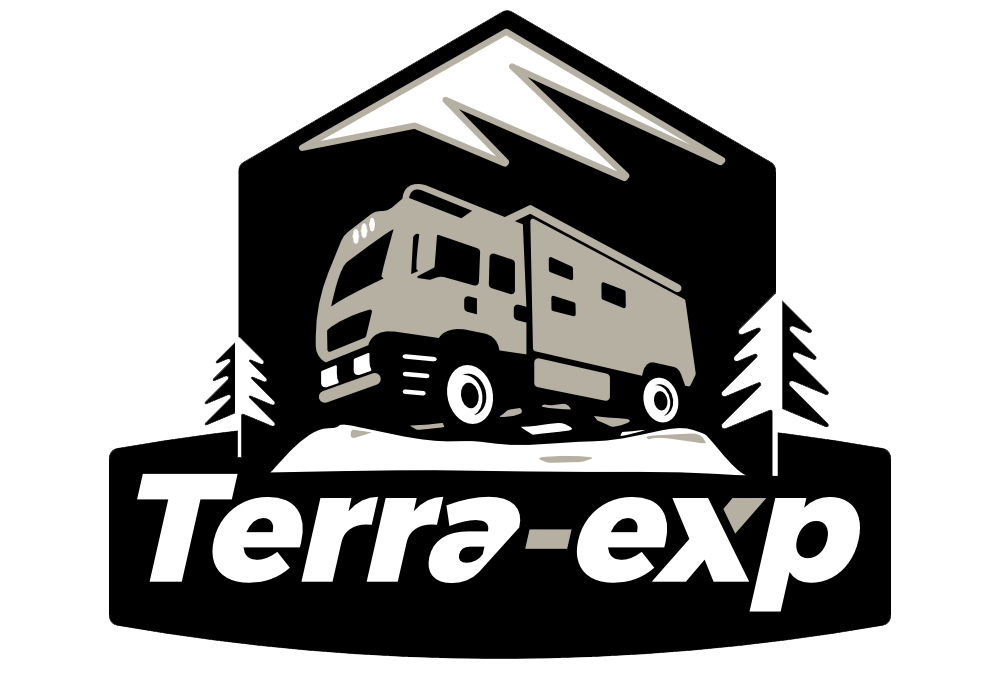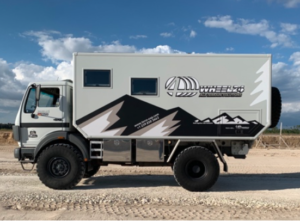 “Is this an Unimog?”
“Is this an Unimog?”
Probably the most asked questions, once somebody approaches our Mercedes Benz Expedition truck.
So, what is an Unimog?
Unimog is an acronym for the German word UNIversal MOtor Gerät. “Gerät” being the German word for a piece of equipment (also in the sense of device, machine, instrument, gear, apparatus). It was created by German engineer Hans Zabel, who made the note Universal-Motor-Gerät on one of the technical drawings for the Unimog.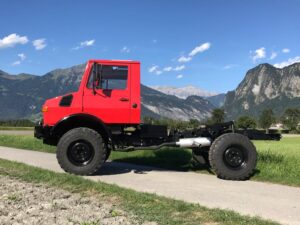
The Unimog’s characteristic design element is its chassis: A flexible ladder frame with short overhangs, and coil sprung beam portal axles with a central torque tube and transverse links. Having portal axles, the tires’ centers are below the axle center, which gives the Unimog a high ground clearance without big tires. The coil sprung axles with torque tubes allow an axle angle offset of up to 30°, giving the tires a wide range of vertical movement to allow the truck to comfortably drive over extremely uneven terrain, even boulder of one meter in height.
The classical Unimog is rear-wheel drive vehicle, meaning that the rear axle is directly connected to the gearbox. Turning on front wheel drive automatically locks both axles, without torque compensation.
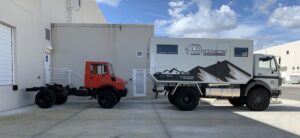 Long story short: The Unimog was designed as an agricultural vehicle/apparatus. The off-road capabilities are enormous. If you are planning of doing 75% and more off-road, this is your vehicle of choice.
Long story short: The Unimog was designed as an agricultural vehicle/apparatus. The off-road capabilities are enormous. If you are planning of doing 75% and more off-road, this is your vehicle of choice.
Unimog (red), NG/SK class (grey)
Everybody else should consider a regular commercial truck with 4WD option from Mercedes Benz. The NG/SK or LK series. With 4WD, differential locks, and hi/lo gearing as well as 46” or 48” tires the clearance and off-road capabilities are comparable to an Unimog. On the other hand, the driver cab is more comfortable and larger, at the same time these trucks have a better sound insulation. The on-road driving capabilities are far better. Since there are no portal axles on a regular commercial truck, there is no preparation necessary (bleeder kit). They also have higher cruising and high-speed capabilities. Last but not least, there are more engines available starting from the 6l inline 6 series, which are used for the Unimog as well up to the 11l/V6 and 15l/V8 engines, natural aspirated or with turbo and intercooler and up to 500hp.
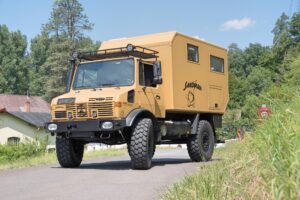
Unimog
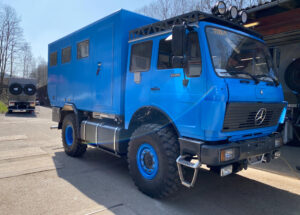
NG/SK Class
FAQ
We consciously choose used all-wheel truck chassis from Mercedes Benz without extravagant motor electronics. The technology is comprehendible even for ambitious professionals. Furthermore, the vehicles can be maintained and repaired all over the world. The engines were build-in multiple trucks which were distributed throughout the world for commercial, military, or firetrucks use.
No matter where your adventure will take you, you will most likely find a mechanic who once worked on a Mercedes Benz truck. With an enormous distribution network, Mercedes Benz is capable of rapidly supporting facilities with spare parts in case this is necessary. We have close to every Mercedes Benz spare part ready and available to ship anywhere in the world within 5 days.
The Mercedes Benz trucks chosen as our Base Trucks are equipped with engines which can utilize heavy sulfate diesel. This lower-rated diesel fuel is still distributed in Africa and some parts of South America. A modern, electronically modified engine will have difficulties using this kind of fuel.
These firetrucks usually come with all-wheel-drive as well as differential locks at the back axle and between front and back axle. Some of the firetrucks have differential locks on the front axle as well. Whereas some all wheel drives are permanent, others can be switched between 2WD and 4WD
Firetrucks come with a longer axle ratio, compared to regular trucks, and in combination with the single wheels these trucks reach 105 to 120km/h (65 to 75mph), allowing highway travelling to be comfortable. At the same time they do have a gear reduction for heavy terrain. Firetrucks are meticulously maintained.
Another important advantage is these firetrucks usually come with less than 50,000km (30,000miles) and are meticulously maintained.
Nevertheless, on top of all these advantages, they are cheaper anyway!
Still got a questions? Contact Us Now
